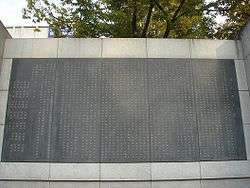Gwangju Student Independence Movement
| Gwangju Student Independence Movement | |
| Hangul |
광주 학생 독립 운동 光州學生獨立運動 |
|---|---|
| Revised Romanization | Gwangju Hakseng Doknip Undong |
| McCune–Reischauer | Kwangju haksaeng Toknip undong |
The Gwangju Student Independence Movement (Hangul: 광주 학생 독립 운동 Hanja:光州學生獨立運動), or Gwangju Student Movement was a Korean independence movement in Gwangju against the 22 August 1910 to 15 August 1945 Japanese rule of Korea. The Gwangju Student Independence Movement took place in October and November 1929. It is considered the second-most important Korean independence movement in the period of the Japanese occupation, with the March 1st Movement considered the most important. The Gwangju Student Independence Movement spread out throughout the Korean Peninsula.
Background

Shortly after the March 1st Movement, the Provisional Government of the Republic of Korea was established which fostered the independence until the liberation from Japan was achieved on .[1] Soon, on 1920, the provisional government led Battle of Qingshanli which is regarded as one of the most successful battles against the Japanese Empire in the independence history of Korea.[2] As a result, the Japan Empire and Japanese General Government responded to this with cruel suppression thus the independence movement faced stalemate. However, as the new clandestine organization for the independence called the Singanhoe was formed in 1927, the independent movement became much more active with clandestine activities. Also, as the Singanhoe embraced various political spectrum in Korea, they could gain much more power to struggle against Japan.
Timeline
The first student movement
On October 30, 1929, Japanese students in the train station in Naju harassed a few Korean female students. This incident was the initial cause of anti-Japanese demonstrations in various high schools in Gwangju. On November 3 — coincidentally both the birthday of Emperor Meiji (明治節) and Gaecheonjeol (Hangul:개천절, Hanja: 開天節), the National Foundation Day of Korea — students were forced to sing the Kimigayo, the national anthem of Japan and hymn to the its emperor. Instead of reluctantly singing it, students remained silent or shouted for independence.[3] Jaeseong Jang, one of those students who participated in this activity, started to lead street demonstrations and insisted that students make this protest into part of ongoing resistance against Japanese rule.
The second student movement
On November 12, 1929, student groups led by Jaeseong Jang distributed mimeographed copies of requests to participate in the movement. Later, students from a few high schools such as Gwangju Agriculture High School and Gwangju Girls' High School decided go on strike against the Japanese regime. In response, authorities decided to impose suspension on students who participated in the movement. This actually led more people to be encouraged to join the movement. Amongst the slogans the students had, the nationalist and socialist views seemed to be distinct.[3]
Aftermath
While the movement was becoming intense, Seokchun Jang, the head of the Gwangju branch of New People's Association, arrived Seoul to report what happened in Gwangju to leaders of New People's Association. From the two conferences he held, he insisted that this movement should become national-wide to struggle for independence. Soon this idea got accepted, and New People's Association began to prepare for demonstrations in Seoul and other major cities. Even though most leaders in Seoul got arrested by the police before their protests, a few schools continued to have demonstrations. This led to the participation from other major political leaders such as Cho Byeong-ok, Han Yong-un, and Song Jin-woo. Eventually, the number of participated schools proliferated by 323.
Effects
Although their protests resulted in the severe repression from the Japanese government, those efforts students made not only encouraged national independence movement, but also became the predecessor of student movements.[4] Sim Hun, the Korean novelist, wrote a collection of poetry Kunali Omyeon (그날이 오면, If that day comes) to commemorate a student independence movement in Gwangju in 1930.[5] In 1953, the National Assembly of South Korea announced the establishment of the Student's Day (학생의 날) to celebrate students' efforts on every November 3. Later, in 2006, this name soon changed into Student Independence Movement Day(학생독립운동 기념일).
References
- ↑ Sources of Korean Tradition, vol. 2, From the Sixteenth to the Twentieth Centuries, edited by Yŏngho Ch'oe, Peter H. Lee, and Wm. Theodore de Bary, Introduction to Asian Civilizations (New York: Columbia University Press, 2000), 336.
- ↑ http://100.naver.com/100.nhn?docid=146563
- 1 2 중앙일보 (2009-11-02). "[그때 오늘] 광주에서 터져나온 일제하 최대의 학생 독립운동". article.joins.com (in Korean). Retrieved 2015-02-18.
- ↑ http://gsim.gen.go.kr/2006/?bo_table=0201
- ↑ Yi, Ae-jeong (2001-08-31), "9월의독립운동가: 심훈", Gyeongsang Ilbo, retrieved 2010-06-30